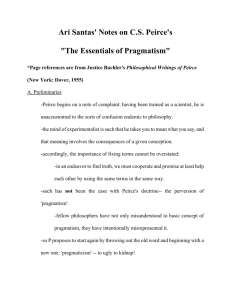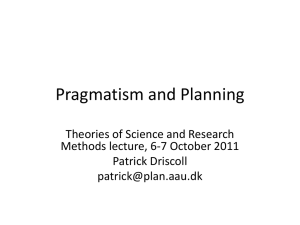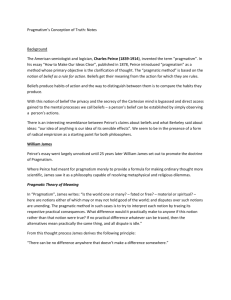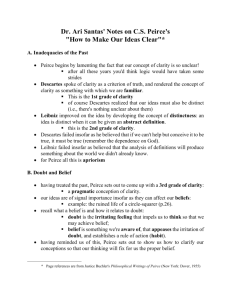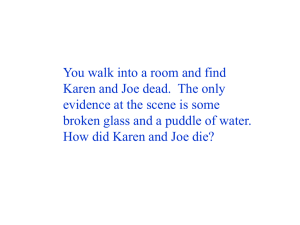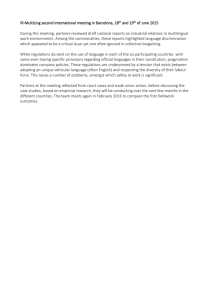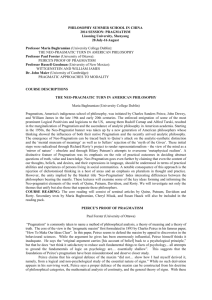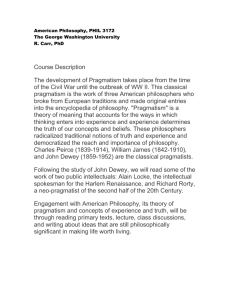Abstract
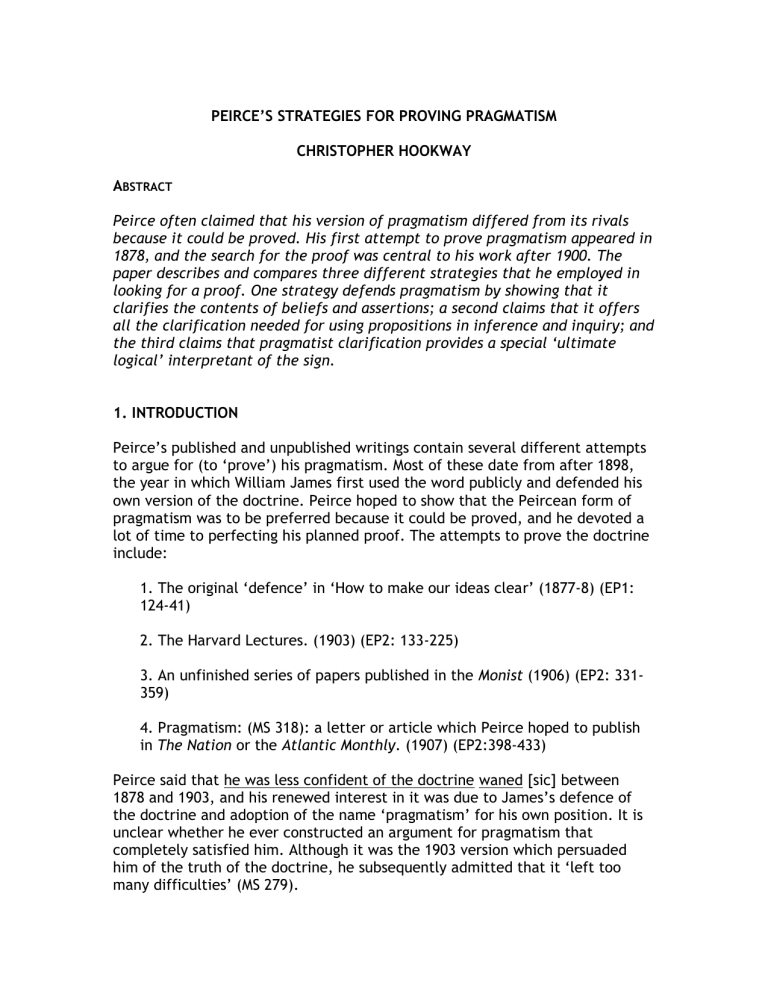
PEIRCE’S STRATEGIES FOR PROVING PRAGMATISM
CHRISTOPHER HOOKWAY
A BSTRACT
Peirce often claimed that his version of pragmatism differed from its rivals because it could be proved. His first attempt to prove pragmatism appeared in
1878, and the search for the proof was central to his work after 1900. The paper describes and compares three different strategies that he employed in looking for a proof. One strategy defends pragmatism by showing that it clarifies the contents of beliefs and assertions; a second claims that it offers all the clarification needed for using propositions in inference and inquiry; and the third claims that pragmatist clarification provides a special ‘ultimate logical’ interpretant of the sign.
1. INTRODUCTION
Peirce’s published and unpublished writings contain several different attempts to argue for (to ‘prove’) his pragmatism. Most of these date from after 1898, the year in which William James first used the word publicly and defended his own version of the doctrine. Peirce hoped to show that the Peircean form of pragmatism was to be preferred because it could be proved, and he devoted a lot of time to perfecting his planned proof. The attempts to prove the doctrine include:
1. The original ‘defence’ in ‘How to make our ideas clear’ (1877-8) (EP1:
124-41)
2. The Harvard Lectures. (1903) (EP2: 133-225)
3. An unfinished series of papers published in the Monist (1906) (EP2: 331-
359)
4. Pragmatism: (MS 318): a letter or article which Peirce hoped to publish in The Nation or the Atlantic Monthly. (1907) (EP2:398-433)
Peirce said that he was less confident of the doctrine waned [sic] between
1878 and 1903, and his renewed interest in it was due to James’s defence of the doctrine and adoption of the name ‘pragmatism’ for his own position. It is unclear whether he ever constructed an argument for pragmatism that completely satisfied him. Although it was the 1903 version which persuaded him of the truth of the doctrine, he subsequently admitted that it ‘left too many difficulties’ (MS 279).
When we examine Peirce’s attempts to defend pragmatism, we face an important question. Are they all attempts to formulate the same general argument? Or does he employ different strategies for defending pragmatism on different occasions? The question is difficult because the topics he discusses in these different texts are rather different.
In the 1903 Harvard lectures, the proof rests on an extended phenomenological investigation of Peirce’s system of categories and the development of a general theory of cognitive norms on the basis of his work in the ‘normative sciences’. The lectures provide a detailed account of
Peirce’s theory of perception and defined pragmatism as ‘the whole logic of abduction’.
The Monist papers contain little phenomenology but emphasise Peirce’s realism and his sympathy for the Scottish philosophy of common-sensism.
The third (unfinished) paper in that series, which was to be the first step in formulating the full proof, was an introduction to Peirce’s late system of formal logic, the existential graphs.
Common-sense is discussed in the drafts of MS318, but there is relatively little on logic and Peirce appears to think that the proof of pragmatism should be worked out within his semiotic, his theory of signs.
The concerns of these different papers appear to be very different. Does this mean that they employ different general strategies? Or do they use different methods for executing a single general strategy?
Sections 5) – 8) of the paper compare the strategies Peirce employed in defending his pragmatism in ‘How to make ideas clear’ (1877-8), The Harvard lectures (1903) and in MS318. Before doing this, we consider three introductory issues.
Why did Peirce think it important to provide a ‘proof’ of his pragmatism?
(section 2);
Just what is the content of his pragmatism? (section 3); and
What were the challenges to pragmatism that he though he had to defeat?
(section 4).
The aim of the paper is to provide an introduction to the issue that was central to Peirce’s work on pragmatism after the doctrine first became famous.
2. PEIRCE AND JAMES
In view of his troubled professional life (see Brent 1993), it is not surprising that Peirce tried to exploit the opportunity provided by the success of James’s defence of ‘pragmatism’. He received recognition as the originator of the doctrine: James and other pragmatists referred to his ‘How to make our ideas clear’ as the first appearance in print of their doctrine. But Peirce wanted recognition for what was distinctive in his pragmatism, and he wanted to establish that his version was preferable to James’s. If his version could be proved – and if James’s version could not be proved – that would give him what he wanted. He always emphasised that his pragmatism was a logical principle – indeed, he said, he had accepted it during the 1870s as a kind of ‘logical gospel’. In James’s writings, he alleged, this ‘logical principle’ became
‘transmogrified’ into a doctrine of philosophy. This identification of the pragmatist maxim as part of logic has important consequences about the need for a proof and about the kind of proof is needed. This may have been in his mind when Peirce wrote, in one of his articles for The Monist, that:
From this original form [of pragmatism] every truth that follows from any of the other forms can be deduced, while some errors can be avoided into which other pragmatists have fallen. The original view appears, too, to be a more compact and unitary conception than the others. But its capital merit, in the writer’s eyes, is that it more readily connects itself with a critical proof of its truth. (EP2: 335)
It is true that James offered no proof of his pragmatism. Pragmatism recommended approaching troubling metaphysical disputes by asking what practical difference it would make whether one side or the other was correct.
In effect, James recommends this approach to defusing metaphysical issues and suggests we try it out: what counts in its favour is the benefits it offers, the fact that it enables us to escape from apparently insoluble problems. Although it fits with James’s instrumentalist account of beliefs and concepts, James does not defend it by showing that it follows from doctrines about meaning and understanding: he merely proposes that we try it out and see if we come to appreciate its benefits (see Hookway 1997). Peirce, the logician, wants to persuade us that it is correct.
3. THE PRAGMATIST PRINCIPLE: LOGIC AND METHODOLOGY
We need to ask two preliminary questions:
1. What is the content of Peirce’s pragmatism?
2. To what purposes does he put it, what is its importance?
1) is both easy and difficult to answer. ‘How to make our ideas clear’ contains a classic formulation of the position with which Peirce remained content as late as MS318. However it is not easy to work out exactly what his convoluted formulation means – and indeed, one reason for my growing interest in the late search for a proof is that I am not as confident as I once was that I do have a clear idea of Peirce’s pragmatist principle! It is easier to approach this issue indirectly by first answering 2). In MS318 we learn that it is ‘no doctrine of metaphysics, no attempt to determine any truth of things.’ Instead it is
‘merely a method of ascertaining the meanings of hard words and of abstract concepts’ (EP2: 400). Indeed, he continues, it is ‘a method of ascertaining the meanings … of what I call "intellectual concepts"’ (EP2: 401) And intellectual concepts are ‘those upon which the structure of which arguments concerning objective fact may hinge’ (EP2: 421). Here Peirce is in apparent agreement with James: applying this principle will give as a reflective clarity about the meanings of propositions and concepts which have important roles in inference and argument.
The first appearance of the doctrine was in a series of papers called
‘Illustrations of the Logic of Science’, and Peirce used his principle for several purposes in his studies of the logic of science. First, the logic of science employs some important logical concepts which are poorly understood, and applying Peirce’s principle clarifies our grasp of them. Thus in 1877 Peirce applies his principle to clarify the concepts of reality and truth: a proposition is true if responsible inquiry into it is fated or destined to converge on a stable belief in it. (EP1:156ff). He also applied it to the understanding of probability: probabilities are explained as long run limiting frequencies. (EP1.142f) Second, applying the principle enables us to see that many metaphysical conceptions are empty, that they lack intellectual meaning and thus can have no role scientific [sic]. In ‘How to make our ideas clear’, Peirce argues that pragmatism reveals the emptiness of the doctrine of transubstantiation, and he also holds that the notion of a ‘thing in itself’ is empty. Finally, applying the principle to clarifying scientific theories or hypotheses reveals all those features of their meanings that are relevant to careful and responsible experimental testing of them.
So what does the principle say?
Consider what effects that might conceivably have practical bearings we conceive the object of our conception to have: then, our conception of those effects is the whole of our conception of the object. (1877. EP1:132)
‘Practical bearings’ is very vague: almost anything could have practical bearings of some sort. If I believe that the wine has turned into blood, then I shall act upon and with it differently from the way I would if I think it is merely wine. That, presumably, is not the sort of practical difference that Peirce has
in mind. [Why not?] Indeed it is clear from Peirce’s examples that having effects with a possible practical bearing will involve making a possible difference to experience. If the ‘fact’ that the wine is now blood makes no difference to the experiences that anyone would have, then the wine’s becoming blood has no effects that have practical bearings. [This is the idea that a difference which makes no difference is no difference at all.] Indeed some of Peirce’s examples suggest that the meaning of a proposition can be clarified by deriving from it judgments about the consequences for experience of our acting on the object in various ways. If it is soluble then, if we stir it in water, we shall see it dissolve; if it is true, then, whoever inquires into it, so long as they do so well enough and for long enough, will be observed to believe that proposition; and so on. This is the sort of information that is relevant to testing hypotheses using the experimental method of the sciences. Peirce seems to have no doubt that applying his principle will involve tracing connections between the truth of hypotheses and the making of observations; and this has led many to interpreting his view as a forerunner of the verification principle of the logical positivists.
Indeed in the introductory section of MS318, Peirce insists that ‘All pragmatists will further agree that their method of ascertaining the meanings of words and concepts is no other than that experimental method by which all the successful sciences … have reached the degrees of certainty that are severally proper to them today.’(EP2: 400-401) We clarify concepts in the way that experimental scientists do: by tracing their implications for possible experience; by identifying what they enable us to learn about the effects on experience of our interventions in the world. As Peirce emphasised in one of his Monist papers: pragmatism is a laboratory philosophy, and pragmatists recognize concepts and hypotheses as legitimate only if they can receive the kind of clarification that is common in the laboratory. And the important part of the pragmatist claim is: such a clarification provides a complete clarification of the concept; it misses nothing out. [sic]
I may return [sic] to the proper understanding of pragmatism later in the paper. For the present I want to register slight puzzlement at the following facts:
1) Peirce’s pragmatism is usually seen as a tool for attacking a priori ontological metaphysics.
2) It is usually seen as defending a form of empiricism – the intellectual content of a hypothesis can be cashed in terms of its implications for future experience, etc.
3) This fits the claim that pragmatism is an experimental or laboratory philosophy.
4) Peirce’s standard formulation of the principle talks of ‘effects that have practical bearings’ and does not explicitly refer to experience.
5) However when he tries to justify his use of ‘pragmatic’ by reference to
Kant’s usage of the term, he refers to pragmatic beliefs as those that enable us to anticipate future experience.
The puzzlement is only slight. It is easy to forge links between experience and practice. If experience is involved in controlling our practical activities, in monitoring whether we are successful in pursuing our ends, then, unless something has implications for experience, we cannot use it as a guide to conduct.
I have one more preliminary comment. As Max Fisch insisted, Peirce’s pragmatism falls within the third branch of logic, ‘methodeutic’ (1986: 374).
The first branch, ‘Speculative Grammar’, yields a general account of representation, of signs and meaning. Critical Logic analyses and classifies the different forms of arguments used within scientific inquiry. Methodology or
‘methodeutic’ attempts to formulate rules and strategies for carrying out inquiries that will enable us to eliminate falsehood and arrive at truth as efficiently and effectively as possible. It will enable us to avoid wasting time by taking seriously the empty garbage which makes up ‘ontological metaphysics’, and it will help us to achieve the kind of clear grasp of the contents of our hypotheses which will enable us to carry out experimental inquiries into them efficiently and economically. The first of these virtues was evident from the anti-metaphysical use to which the doctrine was put in ‘How to Make our Ideas
Clear’, and the importance of the latter is evident from the claim, in the
Harvard lectures, that pragmatism provides ‘the whole logic of abduction’.
The fact that the pragmatist principle is a rule of method yields an important moral concerning the structure of the proof: it must have a two stage character. Since pragmatism is a methodological principle, it is something which should be vindicated in terms of means and ends. We have an aim (or set of aims) which are characterized by the goals specified by the method of science: we want to contribute to the advance of our knowledge of real things whose characters are entirely independent of our opinions about them but which interact with our senses in systematic ways. And the method (the pragmatist principle), is to be justified by showing that adopting it as our only technique for clarifying the meanings of concepts and hypotheses provides the best way of achieving our purpose.(Hookway 2000: chapter twelve)
But, second, it will not suffice simply to show that adopting the pragmatist principle provides the best means available for pursuing efficiently some aim that we happen to have. In Kantian terminology, that would defend pragmatism as a distinctive kind of hypothetical imperative: if you want to use the method of science, you ought to use the pragmatist principle for clarifying
hypotheses. A proof that we ought to adopt the pragmatist principle in our inquiries, rejecting opinions that cannot be clarified through its use and incurring no fear that it may lead us to overlook crucial elements of the meanings of our hypotheses, requires a demonstration that we ought to adopt the aim in question. If it is the best means towards the achievement of a goal that we ought to adopt, then we should make use of it in all of our reflective inquiries. Let us assume that the aim in question relates to the desire to make progress in the sciences and to settle our doubts by arriving at answers which meet Peirce’s characterisation of truth. Then an argument will have to show, first, that it is possible and desirable to adopt this aim and, second, that adopting the pragmatist principle is an effective means towards achieving it.
The famous 1877 paper ‘The Fixation of Belief’ is concerned with the first stage in this argument, with establishing what our aim in inquiry should be. Of the four methods considered in that paper, only the method of science can be consistently employed, and this fixes a definite goal which is to guide us in our inquiries. It employs the ‘fundamental hypothesis’ that:
There are Real things, whose characters are entirely independent of our opinions about them; those realities affect our senses according to regular laws, and, though our sensations are as different as our relations to the objects, yet, by taking advantage of the laws of perception, we can ascertain by reasoning how things really are; and any man, if he have sufficient experience and reason enough about it, will be led to the one True conclusion. (EP1:120)
‘The Fixation of Belief’ argues that we ought to carry out our inquiries in order to contribute to the discovery of this ‘one True conclusion’. It claims to establish the correctness of adopting this goal. All that then remains for the proof of pragmatism is to establish the means-ends claim: employing the pragmatist principle provides our best chance of contributing to the achievement of that goal.
4. THE CHALLENGES TO PRAGMATISM
When we look at an attempt to prove some doctrine, we need to be aware of the doubts that need to answered, of the challenges that can be met. In discussing his proof of pragmatism, Peirce generally has in mind two sorts of challenges. Very simply, we can take it that Peirce wants to defeat two groups of rivals (see Hookway 2000: chapter twelve)
1. Realist metaphysicians. [Shouldn’t this be “a priori metaphysics”?] There are those who practice a priori metaphysics with a clear sense of the value of such knowledge. They use concepts which, they insist, pragmatism would require us to abandon. (eg: Bradley and Josiah Royce) Perice [sic] needs to show that the concepts we cannot abandon are indeed compatible with
pragmatism and to show that, and why, the metaphysicians are wrong to retain their confidence in a priori metaphysical concepts.
2. Nominalists. Nominalistic logicians and positivists think that the pragmatists themselves make use of concepts which are no more respectable than the concepts of the metaphysicians. Peirce’s realism about laws and ‘generals’ would be examples. Peirce needs to show that pragmatists are entitled to the rich conception of experience and the realist doctrines that his version of pragmatism requires.
5. THREE STRATEGIES
In this paper, I want to describe three strategies that Peirce used, at different times, in order to argue for his pragmatism, but I shall not explore them in detail. After describing them strategies [sic] in general terms, I shall consider why Peirce found them attractive and why he also thought that they faced difficulties. They have to be judged in terms of how well they enable us to identify the intellectual meaning of intellectual concepts. The strategies give a central role to three different concepts, three different ideas that might provide a clue to ‘intellectual meaning’. All three strategies are concerned with things we can do with concepts and propositions, things we can do with the special kinds of signs that carry intellectual meaning. And all three are concerned with intellectual acitivities that we can engage in when we use these signs. In this brief section, I shall introduce these three ideas.
1. Belief, assertion and judgment. One things [sic] we do with propositions is believe them, and, in ‘The fixation of belief’, Peirce argued that the end or goal of inquiry (a paradigm intellectual activity) was to replace doubt by belief. In order to be reflectively clear about the intellectual content of a concept or proposition, then, we should be clear about what would be involved in believing it. We can clarify the concept of hardness by explaining what is involved in believing, of some object, that it is hard. Peirce’s first argument for his pragmatism (in ‘How to make our ideas clear’) employs this strategy: pragmatism is a consequence of his account of belief.
Acts of assertion and judgment resemble belief in a number of respects. All three involve a kind of commitment to the truth of some proposition: assertion, we might suppose, typically expresses belief and is sincere only if the asserted proposition is believed; judgement is a kind of internal assertion directed towards oneself and so on. So we can broaden our description of the first kind of strategy: it defends pragmatism by reference to the commitments we incur when we believe, assert and judge propositions.
2. Argument. Intellectual concepts are ones that have a distinctive role in argument and inference, they are concepts on which arguments can ‘hinge’.
Such concepts thus possesses what we might call an argumentative or
inferential role. If argument and inference is essential to intellectual activity, we might suppose that we can clarify a concept by examining its role in argument and inference. Intellectual concepts differ only if their inferential roles differ. This suggests a second strategy for establishing the truth of pragmatism. We give an account of the different kinds of inferential roles, and we show that the pragmatist principle provides all the information about concepts that is relevant to their occupying such inferential roles. The Harvard
Lectures of 1903 seem to employ this strategy. It is also relevant to Peirce’s later claim that his search for a proof failed because he could not show that he had a complete list of the arguments used in science, a complete account of possible inferential roles
3. Understanding and interpretation. It is central to Peirce’s theory of signs that a sign stands for an object because it can be interpreted as representing that object. Indeed when we clarify a concept, or some other sign, we are producing an especially explicit or useful interpretation of it. So perhaps we can establish the correctness of pragmatism by using the concept of interpretation: the pragmatist principle shows how to construct an especially useful or fundamental kind of interpretant.
This need not be different from the other two strategies. For in order to carry it out, we need to ask what makes an interpretant especially useful or fundamental. One answer would be that it makes especially clear what would be involved in believing that proposition; another would be that it makes clear the argumentative role of the concept. But in MS318, Peirce seems to adopt a version of this strategy which is not a special case of the other two. He identifies a special kind of ‘intellectual intepretant’, an ‘ultimate logical interpretant’, and he explains what this means without discussing the classification of arguments and without discussing the commitments involved in belief or assertion. Thus it does seem to provide third strategy.
Before we begin to look at these strategies in a little more detail, we should note that the existence of these different strategies may help us to understand the precise content of Peirce’s principle. The form taken by a clarification of the content of a belief need not be the same as the form taken by a clarification of an argumentative role or of a special interpretant. Since Peirce seemed to shift strategies several times after 1900, this may explain why the content of his principle is formulated in different ways.
6. STRATEGY 1: THE ARGUMENT FROM BELIEF AND ASSERTION
The argument for pragmatism that Peirce used in 1877 depended upon his analysis of belief.
First, it is something that we are aware of; second, it appeases the irritation of doubt; and, third, it involves the establishment in our
nature of a rule of action, or, say for short, a habit. As it appeases the irritation of doubt, which is the motive for thinking, thought relaxes, and comes to rest for a moment when belief is reached. But, since belief is a rule for action, the application of which involves further doubt and further thought, at the same time that it is a stopping-place, it is also a new starting-place for thought. That is why I have permitted myself to call it thought at rest, although thought is essentially an action. The final upshot of thinking is the exercise of volition, and of this thought no longer forms a part; but belief is only a stadium of mental action, an effect upon our nature due to thought, which will influence future thinking.
The essence of belief is the establishment of a habit; and different beliefs are distinguished by the different modes of action to which they give rise. If beliefs do not differ in this respect, if they appease the same doubt by producing the same rule of action, then no mere differences in the manner of consciousness of them can make them different beliefs (EP1: 129-30)
Thus we clarify the content of a belief by describing the habit of action it involves. Inquiry will be helped by information about this habit of action, and this is what the pragmatist principle offers us.
I have mentioned above that Peirce is unclear about the content of his principle. One of his examples of pragmatic clarification involves the concept hard: something is hard when it will not cut by many things. If I believe that something is hard, then this will influence how I act: I won’t try to cut it with a plastic knife; I shall not use it when I want something that can be cut easily.
Beliefs thus interact with desires and background knowledge to cause actions; and knowing what hard means will help me to plan my actions wisely. I am puzzled why we should call this belief itself a habit of action. There is no routine of automatic behaviour that I adopt when I believe that something is hard. At best there is a habit of expectation: I expect attempts to cut the hard object to fail (for example).
Why was Peirce unhappy about this strategy? Or why was he unhappy about his execution of this strategy? The explanation he gives concerns his reliance on the view that beliefs are habits of action. He has no doubt that this is part of what a belief is. But the pragmatist principle is supposed to tell us everything about the intellectual content of a belief, and he has not ruled out the possibility that concepts and beliefs may have roles which go beyond what he has described. Josiah Royce or Bradley, both defenders of a priori metaphysics and opposed to Peirce’s pragmatism, would not think that the claim about beliefs was more certain that [sic] the pragmatist principle itself. If the thesis that beliefs are habits of action leads to the pragmatist principle, that might
just show that the thesis about beliefs was false. It is surprising that Peirce says very little in defence of his claims about belief.
Peirce’s views about assertion may provide a more secure way to make the same move. (EP 2.312f) For Peirce, an assertion is an action (a speech act) through which someone takes responsibility for the truth of some proposition; they commit themselves to its truth. This means that they face penalties – the penalties of the social or the moral law – if they commit themselves to things which are not so. Since intellectual activity involves making assertions and defending them, and also involves inquiring into whether we are right to assert them, then we need to clarify what commitments we undertake when we assert a proposition. What observations, in what circumstances, would show that I can be penalized for my assertion? This clarification faces the future and it requires us to identify what expectations we should have, what experiences we should anticipate, if the proposition is true. This argument – which is hinted at by Peirce but which he may not actually employ – provides further support for pragmatism. But it has a similar weakness to the argument from belief. It does not yet establish that there is nothing more to intellectual meaning: assertion is only part of our practice of inquiry and perhaps other aspects of intellectual meaning are important for other parts of scientific activity.
(Peirce’s insistence that a proposition should be thought of as the possible content of an assertion may be an attempt to fill this gap.)
So these argument appear to show that pragmatist clarifications are useful, that they provide information that will help us to inquire well. But they do not show that the pragmatist clarification provides everything we need. Perhaps we make use of arguments which employ ideas and concepts that have further kinds of intellectual meaning. Perhaps we use such arguments, for example, in deciding whether a systematic scientific theory is explanatory or whether it provides understanding of the phenomena it deals with. Kant supposed that non-empirical concepts influenced the ways in which we propose hypotheses as serious and as explanatory, even if they have no role in the testing of such hypotheses once they have been proposed. (See ‘The regulative employment of the ideas of practical reason,’ Critique of Pure Reason)
7. STRATEGY 2: THE HARVARD LECTURES OF 1903
There is a lot going on in these lectures, and I will not discuss all of it here.
One task is to defend Peirce’s right to use concepts in his logic and philosophy of science which his nominalist critics think he is not entitled to use, and which seem to be inconsistent with pragmatism. For this reason, the lectures contain a defence of realism. Other parts are devoted to giving an account of the nature of norms and showing how we can be justified in relying on logic and epistemological norms without abandoning pragmatism. But the main new strategy is to show that pragmatism provides the ‘whole logic of abduction’.
Although Peirce does not mention this, we can understand it as a response to the Kantian challenge I just mentioned.
For Peirce there are three stages to scientific inquiry: abduction, induction, and deduction. Our grasp of intellectual concepts must enable us to understand how they use them in all three stages of inquiry, in inferences of all three kinds. The abductive stage involves proposing an hypothesis, and showing that it is worth further investigation. We must show that it offers a solution to the problems that led to our inquiry; we must show that it offers a solution with is sufficiently plausible to be worth testing; and we must show that we can test it efficiently and quickly so that we can abandon it if it is mistaken. Unless pragmatic clarifications provided the information we need for doing this, they would not provide a complete clarification of the intellectual meaning of these concepts. Some of Peirce’s metaphysical critics would deny that they can do this: we have concepts with roles in argument that we can understand, that cannot be fully clarified using the pragmatist principle. Kant would have argued that continuity is such a concept: fundamental to thought in metaphysics and science, but not respectable on pragmatist standards.
Facing this challenge, Peirce tried to show, in the Harvard Lectures, that the pragmatist principle can reveal all those aspects of meaning with a role in the abductive stage of inquiry. (In other writings, he showed that the same held for deduction and induction.) It is plausible that this meets a challenge that faces the earlier strategy: this is the objection that there is more to intellectual activity than belief and assertion – there is also (for example) abduction. The first argument did not address this. And Peirce tried to show in 1903 that this challenge can be met. We show that an hypothesis is satisfactory by showing that it predicts the surprising phenomena that led to the search for an explanation. We show how to test the theory by showing what experiential results we expect our hypotheses to have. Pragmatism, it is argued, clarifies the aspects of hypotheses that make them into good explanations. Nothing is missing.
So why was Peirce not content with this strategy – in later writings, he mentioned that it was his favourite argument, the one that finally convinced him that pragmatism was true. The problem is that to carry out this strategy effectively, he would need to identify every form of argument that is used in serious scientific inquiry. And he would need to show that pragmatism clarified those aspects of meaning that were relevant to all of them. His metaphysical rivals would protest that, while pragmatism works for empirical inquiry, there are other kinds of inference and other kinds of inquiry for which it does not work. In his papers on pragmatism in the Monist in 1905-6, Peirce began to construct a system of logic that would provide ‘moving pictures’ of all kinds of inference and argument. If this succeeded, Peirce would possess a compete list of argument forms and thus could show that pragmatism worked for all of them. The difficulties he faced in competing his graphical logic meant that he
did not have a complete list – or that he could not prove that he had a complete list. Unless we have a complete model of intellectual activity, this strategy cannot succeed.
I am fairly sure that this is why Peirce had doubts about this strategy. We might suspect that this despair is unnecessary. Once we find that pragmatism clarifies all we need for these most central forms of argument, it may be rational to hope that it will work for any others that emerge. If alternative argument forms are proposed, then the pragmatist can examine them and evaluate how seriously he should take them as challenges to his position. The requirement that we should be able to rule them out in advance seems unreasonable. After all, Peirce is a fallibilist and we cannot expect an argument for pragmatism that rules out all possible difficulties.
8. MS318 - INTERPRETANTS
In one respect, the strategy followed in this manuscript returns to that of 1877.
Peirce abandons the attempt to take account of all possible kinds of arguments. And he abandons the search for an argument from the nature of belief or of assertion. The similarity with 1877 is that he argues that a habit of some kind – a ‘habit of action’- has a special fundamental role in the complete interpretation of intellectual concepts. If this is enough to establish pragmatism, and if this can be established on the basis of his theory of signs, then he does not need to list all possible forms of argument. We know in advance that any argument with a role in intellectual activity must be consistent with pragmatism.
I shall not go through the different kinds of interpretants that Peirce describes in the different versions of this paper. We are concerned with the class of
‘intellectual interpretants’. We might interpret a sign intellectually by giving a definition of it: pointing out that it has the same meaning of some other more explicit sign. Just as (in ‘How to make our ideas clear’) Peirce said that definitions provided incomplete clarifications because they did not enable us to escape from the web of words and see how a sign is actually used, so, in this manuscript he writes:
It is evident that a definition, even if imperfect owing to vagueness, is an intellectual interpretant of the term it defines. But it is equally evident that it cannot be the ultimate intellectual interpretant, inasmuch as it is itself a sign, and a sign of a kind that has itself an intellectual interpretant, which is thereby an intellectual interpretant of the term defined. (EP2: 430)
He thus looks elsewhere for the ultimate interpretant: it must be a mental occurrence which does not refer to concepts.
Now after an examination of all varieties of mental phenomena, the only ones I have been able to find that possess the requisite generality
[which is required in order to interpret a general concept such as hardness] and which fulfil the other conditions are habits. (EP2: 431)
This is an abstract argument to the effect that, to every general concept, there corresponds a habit which serves as its ultimate interpretant. If this is correct, then we can provide a complete clarification of this concept by identifying and describing this habit. If it is right, we can be sure that there are no arguments which employ parts of the intellectual meaning of a concept which pragmatism ignores. It avoids the difficulties that faced both of the other arguments that we have considered.
But this strategy troubles me too, and at two places. First, even if it establishes that the ultimate logical interpretant of a concept is a habit, it appears to tell us nothing about just what this habit is. Does the argument establish that it has to be a habit of action? Does it establish that it has to bear the relations to experience that pragmatism exploits? The answer seems to be no. If the argument works, it raises the further question: just what habit does an utimate interpretant consist in? And an investigation of belief, assertion, and argument may be required in order to answer that question. But I am unclear about this: perhaps Peirce would say that any habit would do; perhaps he would say that there is only one kind of habit available.
But secondly, I am not convinced that I understand this talk of ultimate interpretants anyway. I agree that we need to escape from the web of words: I interpret the belief that the object is hard when I decide not to try to cut it, or
I take from your hand the knife you are about to destroy by attempting to cut the object. If I do this, I escape from the web of words and show my understanding of the concept. How I act reflects desires and other beliefs as well as my understanding of the belief we are trying to clarify. Peirce’s use of
‘habit’ suggests that he has more than this in mind, that he thinks that a
‘single habit’ corresponds to the concept of hardness, for example. Maybe not.
Maybe it is enough that, together with other beliefs and desires, the use concepts can issue in actions and expectation. Maybe the description I have just offered is the same as what Peirce has in mind. But then we face our earlier problem: we have not established that there are not aspects of meaning which we appeal to [sic] in showing how the concept interacts with other concepts in order to lead to actions and expectations.
9. CONCLUSION
This paper is inconclusive and concerns matters I am thinking about at present.
I am puzzled by Peirce’s search for a proof of pragmatism, puzzled that he is not content with a more relaxed fallible defence of the hope that pragmatism will continue to be as effective as he has so far found it to be. I am interested
in the different strategies he employs in his search, and I hope that exploring these matters helps us to see the relations between some different themes in
Peirce’s pragmatism.
References:
Brent, J. Charles Sanders Peirce: A Life. Bloomington: Indiana University Press,
1993.
Fisch, M. Peirce, Semeiotic and Pragmatism. Bloomington: Indiana University
Press, 1986.
Hookway, C.J. ‘Logical Principles and Philosophical Attitudes: Peirce’s
Response to James’s Pragmatism’, in Cambridge Companion to William James, ed. R.A. Putnam, 145-65.
Hookway, C.J. Truth, Rationality and Pragmatism. Clarendon Press: Oxford,
2000.
Peirce, C.S. The Essential Peirce, Bloomington: Indiana Press. Volume one (ed.
Houser and Kloesel) 1992, volume 2 (ed Peirce Edition Project) 1998. (Referred to as EP, giving volume and page).
